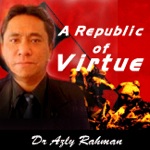Occupy Dataran, too?

But back to the Malaysian scene. If Occupy Wall Street is about a statement made on corporate greed in America, what then is the message in Occupy Dataran? Which Malaysian corporations are the message for? Who is the one percent and which one is the 99 percent?
A REPUBLIC OF VIRTUE
Dr Azly Rahman
“No bulls. No bears. Only pigs” – an Occupy Wall Street poster message.
My weekend was spent thinking about the whole idea of “occupying”. I was preoccupied with it after spending a good three hours visiting the Wall Street protesters. I have been reading about this “global phenomena”, and I read too about “Occupy Dataran”, which I suppose is the idea of occupying Dataran Merdeka in Malaysia. Below are my brief thoughts that preoccupied me after my brief ethnographic trip down Wall Street in New York.
It was fun studying the language of modern day protests. I consider myself an ethnographer of post-modernism and a student of social revolutions, for my early papers during my undergraduate days were essentially about revolution, such as studying the anatomy of the Iranian and Nicaraguan revolutions of 1979.
I wrote about the Computer Revolution in the 1980s and my later work has been on cybernetics and existentialism (as in the title of my blog). My students in Cultural Perspectives were given an assignment to compare and contrast the Arab Spring and Occupy Wall Street, so I wanted to make sure I know what they will be talking about, hence my three-hour visit to the “Occupy Wall Street” move.
I wanted to understand this global phenomena of a protest movement as well and to discern the purpose and the language of it and to analyse the “culture of it” as it becomes popularised. I found some interesting themes that brought me back to my undergraduate days, with my student day movements and my occasional involvement with Amnesty International, especially in the protest against apartheid.
There is an interesting observation I made there. Crude as it may seem, but with an element of “intellectual culture” being displayed, as if there is an “artistic and social” installation being displayed, consisting of the elements of the seeds of a revolution ideologically based on anarchism.
In there are tents with human beings that are ‘nomadic’, a makeshift library of anarchist literature, a food pantry, a kitchenette, a “mini stage” for speeches and street theatre and presentations for radical thinkers to drop by and lend support, anarchistic literature, a “think-tank tent”, an outreach tent, bicycles, and crudely made protest posters .
All these I found to be interesting elements of the reaffirmation and perhaps rebirth of radical consciousness loosely orchestrated by youth wide awake enough to see their society being dominated and hegemonised by corporate culture.
The fact that it was a camp as such, right there on Wall Street, is a radical statement that is appealing enough to the youth of any city in the world and attractive enough a movement to be broadcasted by both the corporate-controlled as well as social and personalising media.
As I was feeling a sense of ‘camaraderie’ with the protesters, who will still be there in the freezing weather, I ask myself: “what do they wish to achieve” in a world in which everything is already structured by the ideology of the “magic of the marketplace” and the Berlin Wall has fallen”?
And when each and every part of our body, our consciousness, or cognitive excursions into the spaces of knowledge and power” and our very existence has been a location and a habitue of the exploitation of corporations and governments alike that have enslaved the mind and the body, and in which spirituality has also been hijacked by laissez faire to be turned into profitable human venture into understanding the divine?
I don’t know. As a lifelong student of both philosophy and cultural anthropology I do not have the answer to the meaning of what we are seeing in Occupy Wall Street or even “Occupy Dataran”, when essentially I still believe that radical changes can happen best through total change, cultural re-engineering, the dismantling of the corporate capitalist system and perhaps “re-villagisation” of human beings and to reorganise ourselves into “communes”. I don’t know.
America is America. And especially New Yorkers are a people of a strange planet. To us, this is just a protest, like any other – on gay rights, Palestinian rights, Israel’s rights to exist, rights of animals, of the Tibetans, to eat super-sized McDonalds everyday, rights of the New York City’s naked cowboy to sue his business rival , the naked cowgirl, etc. Life still goes on because arguments or discourse has been so relativised and post-modernised and debated of its pros and cons and its subjectivity that anything goes.
But back to the Malaysian scene. If Occupy Wall Street is about a statement made on corporate greed in America, what then is the message in Occupy Dataran? Which Malaysian corporations are the message for? Who is the one percent and which one is the 99 percent?
How have the corporations in Malaysia been instrumental in the project of alienating, marginalising, and plundering the “people” or the “rakyat”? How will the structure of control be exposed? What is the nature of political economic control? Who owns what, through what means?
These are the questions that interest me as we see Malaysia too undergoing what Chairman Mao would call “interesting times”.
DR AZLY RAHMAN, who was born in Singapore and grew up in Johor Baru, holds a Columbia University (New York) doctorate in International Education Development and Master’s degrees in the fields of Education, International Affairs, Peace Studies and Communication. He has taught more than 40 courses in six different departments and has written more than 300 analyses on Malaysia. His teaching experience spans Malaysia and the United States, over a wide range of subjects from elementary to graduate education. He currently resides in the United States.
https://www.facebook.com/#!/azly.rahman
http://azlyrahman-illuminations.blogspot.com/

